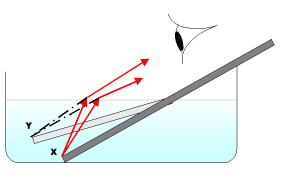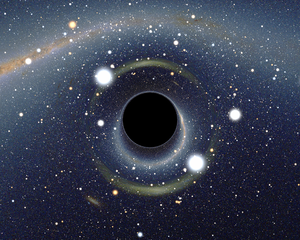Every object can be classified as Transparent: Objects that light to pass through completely, Translucent: Objects that allow light to pass through partially and Opaque: Objects that do not allow light to pass through them.

Transparent objects have a special property called Internal Reflection. This property is because of the fact that light bends when it travels from one medium to another or simply, when it refracts. When a light ray travels form a optically rarer medium to a optically denser medium, it bends towards the normal. In the same way, when light travels from and optically denser medium to optically rare medium, then it bends away from the normal.
 When you keep increasing the angle of incidence, the ray of light keeps bending away from the normal and a point comes when the ray travels along the surface of the object or the medium. This angle is called as the critical angle. If you increase the angle further, then the ray of light wont refract but simply reflects. The type of reflection is called as the Total Internal Reflection. Its called as the Total Internal Reflection because the light ray that strikes it is reflected completely without 0.0001% of energy being absorbed.
When you keep increasing the angle of incidence, the ray of light keeps bending away from the normal and a point comes when the ray travels along the surface of the object or the medium. This angle is called as the critical angle. If you increase the angle further, then the ray of light wont refract but simply reflects. The type of reflection is called as the Total Internal Reflection. Its called as the Total Internal Reflection because the light ray that strikes it is reflected completely without 0.0001% of energy being absorbed.
Differences between TRI and Reflection
The critical angle of an object calculate with the equation given below:
sin ic = n1 / n2,
where ic is critical angle, n1 = refractive index of vacuum and n2 = refractive index of material [n1=1(always) because we are checking the critical angle with respect to air, i.e a light ray is travelling from a given medium to air.]
Here is a list of critical angles of a few materials:

Transparent objects have a special property called Internal Reflection. This property is because of the fact that light bends when it travels from one medium to another or simply, when it refracts. When a light ray travels form a optically rarer medium to a optically denser medium, it bends towards the normal. In the same way, when light travels from and optically denser medium to optically rare medium, then it bends away from the normal.
 When you keep increasing the angle of incidence, the ray of light keeps bending away from the normal and a point comes when the ray travels along the surface of the object or the medium. This angle is called as the critical angle. If you increase the angle further, then the ray of light wont refract but simply reflects. The type of reflection is called as the Total Internal Reflection. Its called as the Total Internal Reflection because the light ray that strikes it is reflected completely without 0.0001% of energy being absorbed.
When you keep increasing the angle of incidence, the ray of light keeps bending away from the normal and a point comes when the ray travels along the surface of the object or the medium. This angle is called as the critical angle. If you increase the angle further, then the ray of light wont refract but simply reflects. The type of reflection is called as the Total Internal Reflection. Its called as the Total Internal Reflection because the light ray that strikes it is reflected completely without 0.0001% of energy being absorbed. |
| Total Internal Reflection | Reflection | |
| 1. | The Light ray bounces back completely | Some of the light ray that strikes is absobred |
| 2. | This takes place at particular angles only(Θ>C) | This takes place at all angles. |
| 3. | Possible only in transparent and translucent objects. | Possible in all objects. In fact, the reason we see them is because they reflect light! |
The critical angle of an object calculate with the equation given below:
sin ic = n1 / n2,
where ic is critical angle, n1 = refractive index of vacuum and n2 = refractive index of material [n1=1(always) because we are checking the critical angle with respect to air, i.e a light ray is travelling from a given medium to air.]
Here is a list of critical angles of a few materials:
| Material | Critical Angle |
| Glass(Acrylic) | 42.155° |
| Crown Glass | 41.810° |
| Flint Glass | 38.682° |
| Pyrex(a borosilicate glass) | 42.86° |
| Rock Salt | 41.271° |
| Diamond | 27.407° |
| Acetone | 47.332° |
| Water | 49.761° |
























.jpg)
